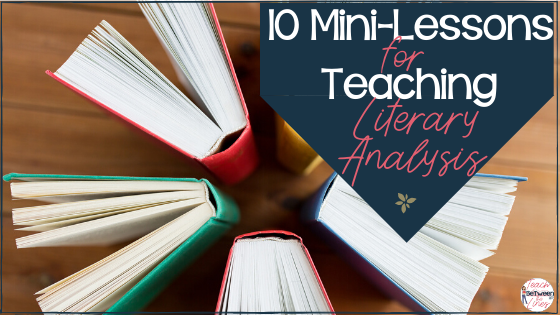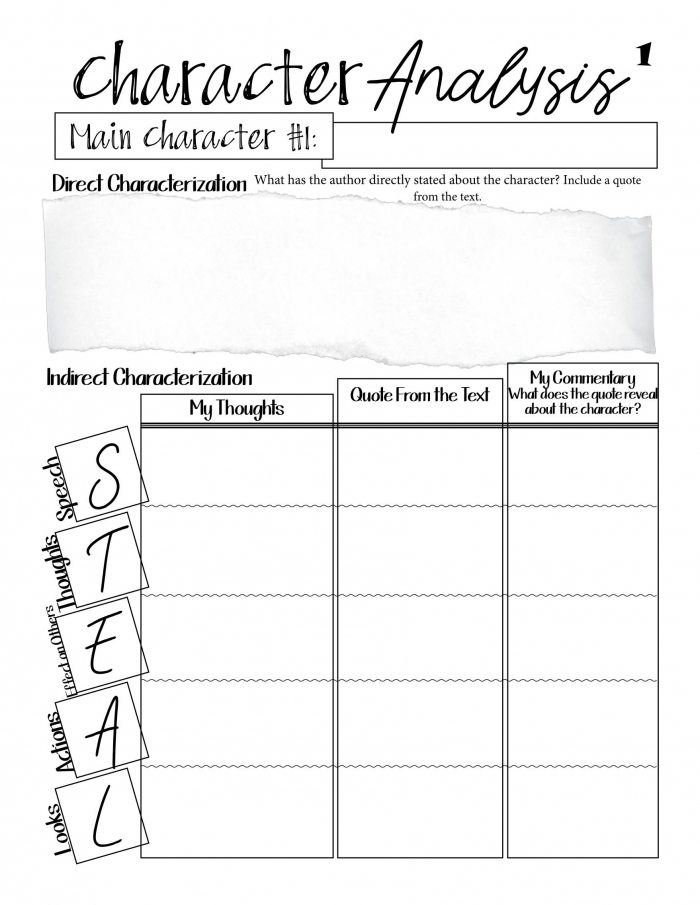English Teacher Life – A Blog for Secondary ELA Teachers to connect over our unique content. English teacher inspiration, ideas, lesson ideas, and free ELA resources!

As soon as I would say the word “analysis” in my classroom, my students would groan, slumping down in their chairs, flailing their hands for dramatic effect. I get it. Writing responses to literature can be difficult, even for high school students. This was especially true when the analysis didn’t have a specific prompt for students to follow. They became overwhelmed, unsure of where to start. It was when I started teaching how each element fits together in a narrative that they started to really produce incredible pieces of writing focused on a true analysis of the text. They started explaining how the dynamic characters and their conflicts throughout a story shape the theme. Papers had quotations, with correct citations, as evidence to support their claims. My students were excited about what they were learning and writing!
Supporting your learners by teaching the elements of a literary analysis is a great starting point. I began by breaking down each element on this literary analysis poster. Modeling it first and choosing relevant activities to review each element made a huge difference! I introduce each element of literature as a topic that can be addressed through well-written literary analysis. Here are some ways you too can teach literary analysis in your classroom!
iSEE
As I introduce the different elements on this poster, I ask students to craft a short literary analysis on each. I use the iSEE method for drafting a quality literary analysis paragraph. They apply this method through each of the mini-lessons below, so it becomes comfortable, familiar, and downright easy to draft that true analysis of a text.
iSEE stands for:
inference
summary (of the text so far)
evidence
explanation
With whatever element you are focusing on, your students can make an inference focused on the element, write a brief summary of the text so far, cite evidence to support that inference, and explain it further.
Literary Elements to Teach in Connection with Literary Analysis
1. Tone/Mood
Tone is a challenging concept for students. They often have a difficult time considering the author’s attitude about the subject in which they write. I spend a fair amount of time on this unit each year. I use music, video games, film, art, literature, photography, and memes to help my students understand tone and mood. This is a perfect way to show your students that tone and mood can be very different given the context of story or situation.
Your students can analyze tone using the iSEE method. First, students will make an inference as to the tone of the piece. In To Kill a Mockingbird, students may identify the tone at the beginning of the novel as reminiscent. They will then move to the S of the method and summarize the text so far. Chapter one of To Kill a Mockingbird explains the background of Maycomb, Alabama and the Finch family through the eyes of the narrator, Scout. Next, your students will provide evidence (E) to support their inference. In this case, students may quote parts of the novel where Scout lists the names of her ancestors. Finally, the last E is where your students will further explain the evidence selected and how this supports the tone identified within the inference statement.
2. Irony
In a lot of young adult literature, irony helps students determine the theme of a text. It’s what you don’t expect to happen (or the character doesn’t expect) that can lead readers directly to the lesson or message.
I like using film clips to teach irony. Dramatic irony is often prominent in film because the audience is often let in on secrets that the characters themselves don’t know. An episode of a TV sitcom like “Friends” or “Three’s Company” might find the characters in silly situations where the audience knows the predicament but the character does not. “The Necklace” by Guy de Maupassant is an excellent piece of literature to analyze when looking for irony. In this case, the irony presented in the text is situational irony as the reader and character are surprised by this unexpected event! Students love this part of the text, and you can often hear students gasp as they finish the story. They can then practice the iSEE method inferring (or in this case identifying) the type of irony – situational – and then finishing with the iSEE steps to fully explain the impact of this irony on the text.
3. Theme
Help your students analyze the theme or message of a work of literature. With the theme, I teach my students to track the topic. We’ll start with the central idea right when we begin the novel. I ask my students to notice any evidence that supports that idea throughout the text in order to see the development of the theme. For example, I teach my students to recognize how power corrupts in Shakespeare’s Macbeth using a theme tracker or elements of social injustice throughout To Kill a Mockingbird.
When we finish the text students will be able to craft their theme statement based on the evidence they have collected. As an added bonus they have already done the challenging task of finding evidence to support their inference!

4. Characterization
Characterization is another important element of literary analysis. A Character can drive the plot, influence theme, and is integral in conflict. That’s why it’s so important to teach these literary elements in connection with one another. When I ask students to read a text for this element, I ask them to track the character development (just like the theme.) Students can use the STEAL method to find examples of character development while they read. This will help them to identify a specific character trait in the inference statement, and pull evidence to support this right from this already completed worksheet! Click on the image to learn more about this unit!
5. Figurative Language
Analyzing literature is also about understanding language. Teach your students different types of figurative language and how it impacts writing in a story. I teach my students to focus on several types of figurative language in stories:
simile
metaphor
idiom
personification
alliteration
imagery
onomatopoeia
With figurative language, it’s not about recognizing them in isolation but analyzing how they fit the rest of the literary elements of the story. Do the idioms contribute to the setting and plot? Is the character’s journey a metaphor for something deeper? Analysis becomes deeper when figurative language enters the picture!
I think about how Scout personifies Maycomb in To Kill a Mockingbird. She describes her hometown as a “tired old town”. The imagery and personification directly help your students understand the setting and that the Alabama town is almost a character in itself.
I love using poetry to help students practice the identification of figurative language. Using paired passages of poetry and fiction is one way to incorporate figurative language into your instruction.
6. Conflict
Conflict drives the plot in a story. The initial conflict that builds towards the climax may be internal or external, but no matter what, I always remind my students that conflict is something that should be analyzed in connection with plot and character.
The text may have dozens of different conflicts, but I always ask my students, “what is the driving conflict in the story?” Try this with your students. Have them chart the main conflict using the iSEE method. Then, let them make an inference as to the main conflict of the text. Throughout the text, have them chart and identify all conflicts that contribute to the main conflict in the text and explain how it affects the inciting incident.
7. Narration/Point of View
When analyzing point of view, I often ask my students, “What do you know about the characters/plot based on the point of view?” As a follow-up, I inquire, “How would the story potentially change if the point of view changed?”
Imagine To Kill a Mockingbird if Atticus told the story or Calpurnia was the center. What if we only knew a third person limited perspective? Would some of Scout’s innocence be lost? Would we really understand what happened with Boo Radley?
This is something students can reflect on in Readers’ Response Logs, a resource that can help students make connections and record their inferences and evidence to lead to deeper literary analysis.
8. Plot
Remind your students that without a plotline, you don’t have a narrative. Understanding the elements of the plot is integral to literary analysis. Most high school level texts contain multiple plot lines. For example, in the novel To Kill a Mockingbird, readers will recognize a plotline following Scout and Boo that runs parallel to the story of the Ewells and Tom Robinson.
Use the iSEE method with your students to ask them to identify the climax of the plotlines in your class novel. Support the inference with a summary of the plot including the exposition, initial conflict, and rising action for the given plotline. Then, have your readers add evidence and explain why the identified event is the turning point of the climax of the book.
9. Genre
Literary analysis is primarily focused on fiction (although literary nonfiction in the form of memoir, autobiography, biography, or other narrative nonfiction may be used as well). There are many different genres that may be explored using literary analysis in fiction, and genre can certainly contribute to the analysis. Some genres you may explore in your classroom include:
realistic fiction
historical fiction
fantasy
science fiction
horror
literary fiction
speculative fiction
young adult
magical realism
Have your students mention genre and reflect upon it as they engage in literary analysis.
10. Symbols
One of the most challenging elements when it comes to literary analysis is symbolism. My students often struggle when I ask them to look at objects or allegorical characters in the novel and see them outside the literal meaning, but using the iSEE method really helps them start to analyze symbolism in a text.
For example, in the memoir, I Know Why the Caged Bird Sings by Maya Angelou, your students can infer what the “caged bird” symbolizes, summarize the text, and provide specific evidence and additional explanation using the iSEE method.
Using paired texts to see common symbols in other works of literature can also aid in literary analysis. For example, the poem “Sympathy” also uses a symbol of a caged bird as in Angelou’s work.
Overall, using the iSEE method and the 10 major literary elements can help your students become proficient at literary analysis and improve their reading and writing skills. Have your students reflect on how the various literary elements work together to make a complete work, relate to other texts, and connect to real-life world problems and events. Literary analysis is a powerful tool in developing higher-level thinking for your students. It’s definitely helped my students become more confident in their writing and sharing their ideas!